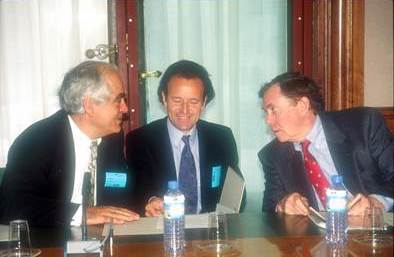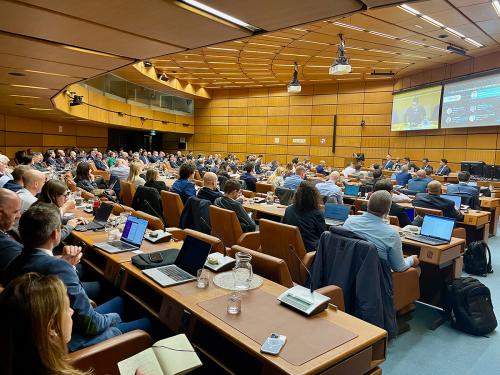20 Years of the OECD Anti-Bribery Convention -nudging for good

Last week two celebratory events took place that at first glance appear to have little in common: One was the annual awarding of the Nobel prizes in Stockholm. The other was in Paris, and it marked the 20th anniversary of the OECD Convention on Combating Bribery in International Business Transactions (‘Foreign Bribery Convention’).
The Nobel laureate for economics, Richard Thaler was awarded the 2017 prize for his work on behavioural economics, including the “nudge theory.” In his Nobel acceptance lecture Thaler referred to the phrase he uses when signing his books: “nudging for good,” that involves pointing people in the right direction, but without forcing them to do anything. Many of the anecdotes recounted at the OECD meeting suggested that the Foreign Bribery Convention’s genesis and development over the last 20 years came about through a combination of leadership, competitive behaviour and coaxing - or nudging – that resulted in the treaty being signed in 1997.
The OECD event brought together three protagonists each of whom played an important role in making the Convention the most effective treaty on combating corruption in the world today. Peter Eigen, the founder of Transparency International, Donald Johnston, at the time Secretary General of the OECD and Professor Mark Pieth who was Chairman of the Working Group on Bribery from 1990 to 2013. They discussed the obstacles that had to be overcome during the negotiation of the Convention as well as its subsequent development. Their reminiscences illustrated how the behaviour of the member countries was nudged towards taking important steps to change the default position; that it was not only acceptable for companies to pay bribes when conducting business abroad, but these bribes were even tax-deductible.
The discussion on bribery that led to the development of the OECD Foreign Bribery Convention reflected the economic and business aspects of the issue: The OECD countries were home to the companies that were the target of the Convention, and corruption was seen as a competition issue. Briefly stated, the mandate of the informal working group that started the early discussions at the OECD was to “multilateralise the US Foreign Corrupt Practices Act.” Levelling the playing field for the private sector was the imperative that drove the negotiations with the US pushing for an OECD Recommendation. The impetus for a more binding instrument was then driven by the French and Germans, as they advocated an international treaty was necessary to ensure that every country would be held to the same standards. After signing the Foreign Bribery Convention on 17 December 1997, it came into force less than two years later.
As Mark Pieth remarked, a lot of the ground work had been covered between 1994 and 1997, so that by the time the Convention came to be written it was achieved very swiftly – he mentioned three idyllic days at Lake Lugano that combined swimming in the lake with drafting of the text of the Convention. While the transition from Recommendation to international Convention went relatively quickly, it took another ten years or so for the momentum of implementation at the country level to develop and for the effectiveness of the Convention to materialise.
All the member countries of the Working Group on bribery (currently 43 countries) meet four times a year and these exchanges combined with the separate prosecutors’ meetings have provided opportunities for mutual nudging to ensure that all the members are now compliant with all the legislative requirements of the Convention. This has largely been achieved through the effective peer review monitoring that has been a crucial element in the success of the Convention.
This rigorous peer review at the OECD Working Group on Bribery involves consensus; all member countries discuss and agree the reports (minus one – the country being evaluated cannot block the report), the reports are then all published in full on the OECD website. Mandatory publication and consensus on the peer-review reports are the two key elements that distinguish the OECD Convention from other international or regional treaties that address bribery and account for its effectiveness. Peer review monitoring as exercised by the Working Group could be described as nudging on an institutionalised basis: the countries that are held to account by their peers do not hesitate to exercise the same level of scrutiny.to which they have been subjected. This creates a virtuous circle as countries jockey towards a level playing field.
At the OECD event last week, Mark Pieth recounted how the Working Group developed the ‘Bribery case matrix’ that became a tool to nudge countries into sharing information on allegations and cases. This ‘Matrix’ was first developed as a list of cases that raised allegations of bribery against companies was initially culled from public media sources, and compiled for the Working Group to review. Mark Pieth recalled that several countries immediately voluntarily decided to correct and supplement the information compiled in the Matrix. Where a few countries led, others soon followed and in so doing, the basis for the active sharing of case information across the Working Group was created.
Today, this Matrix is a substantial document of several hundred pages that provides the basis for regular review of progress of cases and discussions at the Working Group meetings. The Matrix is now confidential given that it is no longer confined to public source material. It illustrates how Choice Architecture (according to behavioural economists), can point people in the right direction. In this instance, the Matrix provided the choice for countries to contribute their information to a document that promotes dialogue and enables more efficient cooperation between countries, which can help to ensure that investigations into allegations of bribery are initiated and pursued.
All the panelists agreed that there have been major steps in the last 20 years to address bribery and that the OECD Convention is part of a bigger picture that includes the UN Convention against Corruption and a range of regional treaties, all contributing to the fight against corruption. This is not to say that there is not a lot more work to be done and the publication issued last week by the OECD on The Detection of Foreign Bribery last week indicates the progress made, but also that many more member countries need to take the plunge and start prosecuting bribery cases.
The panelists also expressed the view that the private sector needs to be more actively engaged as a partner in the fight against corruption than was originally envisaged in 1997, or as Peter Eigen put it: “Poor global governance can only be met by Collective Action.” The study that the OECD announced for next year on bribery case settlements will strike a chord with the private sector and provide an opportunity for collaboration and furthering the work of the OECD Working Group on Bribery.
The OECD Convention and the other anti-corruption international instruments all have a role to play in countering bribery, as do the private sector, civil society and private citizens. We all have to ‘nudge for the greatest benefit of mankind’ as Richard Thaler said as he raised his glass to toast Alfred Nobel in Stockholm.




